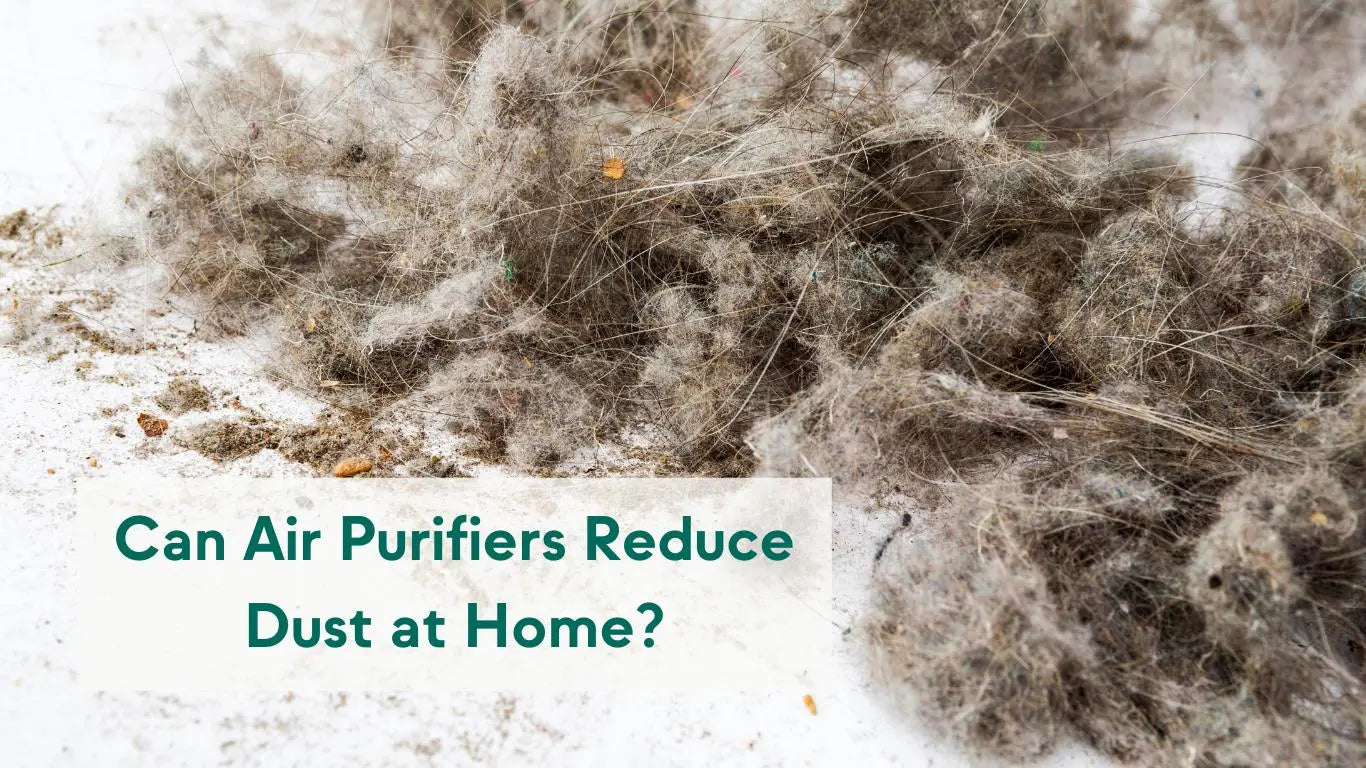
Too much dust can be the cause of serious health problems. Air purifiers are an essential tool to help reduce dust at home.
Dust is an unfortunate event we are all subject to in life. No matter what type of home you live in, or where you are located geographically, dust will settle and accumulate on all of the surfaces of your home. While outside of a highly controlled clean-room we will never be completely free of dust, there are several tools we can use to help reduce the amount of dust in our environment. One particularly effective way to reduce household dust is using an air purifier.
With pollutants like dust, bacteria and smoke collecting in your home, it comes at no surprise that air purifiers are seen as an affordable solution to eradicating unwelcome pollutants.
But how much do the best air purifiers help with dust, and why should you care?
You might already be using air purifiers because you’re tired of allergy flare-ups. After all, indoor air is two to five times more polluted than outdoor air, according to the EPA. According to Dr Clifford Bassett, allergist and immunologist, small particles such as dust irritate your lungs and nasal passages, which may well trigger an allergic response in some people.
Does An Air Purifier Help with Dust?
If you take a look at the fine print on any air purifier's packaging, you'll see a fair number of promises. Some air purifier companies vow to eradicate up to 99.9995% of dust and viruses, while others brag about curing dust allergies for good.
In reality, the science behind air purifiers is a little more complex.
While you might think that the root of your allergy problem lies within dust itself, it’s actually dust mites that are the main origin for the allergy. According to an immunology professor who has developed the main guidelines for treating dust mite allergies, these tiny creatures are almost the same size as most dust particles, and feed off dead human skin in carpets, furniture, and beds.
While air purifiers are effective at removing the majority of the air particles from a single room, they certainly can’t take away all the particles, and definitely not those that have deposited onto walls, floors and furniture.

What is dust made of?
In order to understand how an air purifier can help to reduce dust in your home, first you must understand what dust actually is.
Although it will often look like uniform grey dirt when it settles on surfaces, dust is actually a collection of many different kinds of micro particles that come from a wide number of sources.
The exact composition of indoor dust, for instance, will vary between each and every household, and is based upon a number of factors, including how many people and pets live in the home, the outdoor environment, and even what foods are typically cooked and consumed. For most of us, however, dust is mostly composed of particles that originated outdoors to begin with, and found their way indoors.
Outside particles include pollens, mold spores, and other organic debris. These are harmless to most people, except for those who have health conditions that can be triggered by inhalation of environmental contaminants, such as allergies and asthma. Cigarette smoke, whether it originates from outside or inside the home, also contributes to the formation of dust.
While it does not comprise a big percentage of dust, as myths would like you to believe, our skin cells and hair, as well as our pets’ dander and fur, are commonly found in household dust.

In addition to the vast range of sources that contributes to the formation of dust, these different particles all range significantly in size. Dust mites, for example, are actually quite large in terms of dust, while Pollens can range from huge to extremely small. Other particles that make up dust can be even smaller than that. Face powders and pigments from paint can get down to as small as 0.1 microns inside, and toxic chemical residue like cigarette smoke can range from 4 to 0.01 microns.
Is dust dangerous to our health?
Dust may seem relatively harmless, but it can indeed become harmful to our respiratory system. When our lungs are exposed to high levels of dust for prolonged periods of time, the risk of disease increases dramatically.
Inhaling dust is a severe health risk
Several factors influence the effects of dust particles. For example, how deeply the particles are inhaled into the respiratory system or the length of exposure. Other factors, such as whether you breathe in through the nose or mouth, may also influence the effects. Using an air purifier to help reduce dust will remove it from the air before it reaches your lungs.
Offices are worse than homes
Offices normally have higher dust concentration than homes, because of the higher traffic of people, as well as frequent use of chemicals.
Where dust is an issue workers are at-risk of dust-related illnesses like dusty lung. When this happens, inhaled dust particles produce scar tissue in the lungs, and particles may even dissolve into the bloodstream, causing potential toxicity to spread to vital parts of the body, including the brain and kidneys.
How do air purifiers eliminate dust?
In theory, the fibers in a High Efficiency Particulate Air (HEPA) filter will filter out 99.97% of airborne particles at least 0.3 microns in size, according to the EPA. So, although HEPA can easily filter all the common pollutants like dust, pollen, mold, and bacteria, most of these are fine particles mostly under 2.5 microns, and the peskiest at sparking health problems.
While air purifiers with HEPA filters claim to clean almost entirely dust from your home, they can’t eliminate the majority of the “dangerous stuff”.
For this reason, it’s still necessary to take other actions to fight off dust completely like proper ventilation and removing pollutants at their source.

Can air purifiers help with dust mites?
No one wants to share their home with unwanted intruders, and unfortunately, it’s not uncommon for dust mites to take a liking to your home. So much so that several studies found dust mites present in 84% of beds in the United States.
For those with a dust allergy, this poses a huge health problem.
For many people, it’s the proteins in the dust mite droppings rather than the mites themselves that cause allergic reaction, according to scientists. Once the dust mites fed on your dead skin cells, the enzymes they use to break down the food come out the other end in small fecal pellets, which are incredibly potent allergens.
These droppings get caught up in things like carpets, rugs, blankets and curtains. So rather than relying on an air purifier for home and office, the best way to get rid of dust mite droppings is to actually dry steam furniture and soft furnishings, vacuum carpets, and switch out your bedding for an allergen-proof alternative.

How to check if air purifiers are helping with dust
Once you’ve turned on your air purifier, it can be tricky to notice if anything’s happening at all. A good long-term strategy to quantify how much your purifier is helping with dust is to pausing before you make your purchase and note your symptoms. After purchasing an air purifier, do the same and compare notes.
The most common way, however is to check your air purifier’s clean air delivery rate (CADR). The CADR is based on the airflow rate and removal efficiency. This measures how much clean air the device can output in cubic feet per minute.
Above all else, personal experience may be your best indicator of efficacy.
You should notice that the sniffles and itchy noses that have been troubling you starting to improve. That would suggest there are fewer dust particles, dust mite droppings and other pollutants causing an allergic reaction.

6 Ultimate Tips to Reduce Dust at Home Once And For All
-
Buy an Air Purifier for Dust
The best air purifiers on the market can remove upwards of 95% of airborne particles, which can help you effectively control and reduce dust in your home.
A side benefit of using an air purifier is that it reduces the need to dust your home. When air purifiers are run 24/7, they reduce, and may even eliminate, the need to dust your furniture and home.
When researching air purifiers, it’s important to consider units without carbon components in its filters. Although carbon is great at removing odors, it’s also quite expensive and you’ll have to replace it quite often.
Additionally, we suggest you purchase air purifiers that have a fan. These units blow air across the floor and kick up dust on the floor, making it much easier for the filter to capture these pollutants.
It would also help if you choose an air purifier with ionizers. Ionizers not only help the air remain fresher, but they also emit charged particles that help air purifier filters capture pollutants that otherwise would be too small to filter out.
-
Monitor Indoor Air Quality (IAQ)
Although there’s an increased interest in air purifiers, air quality monitors allow you to measure the quality of air in your home. These monitors check oxygen, carbon dioxide, carbon monoxide, radon, and volatile gases presence in the air. They can also detect particulate matter, including dust, pollen, mold, and smoke.
-
Clean Often and Well
When cleaning, it’s essential to start at the top of the house and surfaces and work your way down to the bottom. By cleaning the highest surfaces first and working your way down, you can ensure you catch all the dust as it falls.
-
Upgrade Your Furnace Filter
Homes with forced-air heating or cooling systems can control and reduce dust by filtering the air. Using an electrostatic filter that connects to your ductwork is considered the most effective method of eliminating dust. Unfortunately, it would need to be installed by a professional and can cost between $600-$1,800.
-
Clean Your Bedding Weekly
Regularly changing your bed sheets is more important than you realize. If you don’t change your bed sheets often, they can become a major collector of dust. This dust includes everything from skin flakes to fabric fibers. Washing your bedding weekly in warm water can help to eliminate dust and keep dust mites in check. You should also clean non-washable items by taking them outside and giving them a good shake.
-
Use Baby Wipes
Baby wipes are not only antibacterial and disinfectant, but they are also perfect for dusting around the house. Many people recycle them as dust cloths after use. These cloths can help remove dust from narrow spaces such as keyboards. Some brands of baby wipes work exceptionally well at removing dust after being laundered.
A conclusive note
No matter how clean you are, dust will always accumulate in your home or office. Some of the most common dust sources include dead skin cells, bedding, furniture, and clothing. According to a recent study, 60% of the dust we find indoors originates outdoors, mainly from airborne particles in the soil, plants, and animals.
Unfortunately, we cannot wholly avoid dust. However, there are a few ways to get rid of dust in your home. Placing an air purifier in every room is probably the most effective way to eliminate dust from the air collectively. People who suffer from dust allergies and asthma would benefit from the use of air purifiers immensely.
Modern advancements in air purification technology allowed us to develop KORU Air focusing on maintaining an extremely high air purification effectiveness, while limiting our impact on the planet and on customer’s pockets with a permanent and washable filter.

Share:
Bird of Paradise Plants Care: Guide & Tips
Boston Fern Plants Care: Guide & Tips